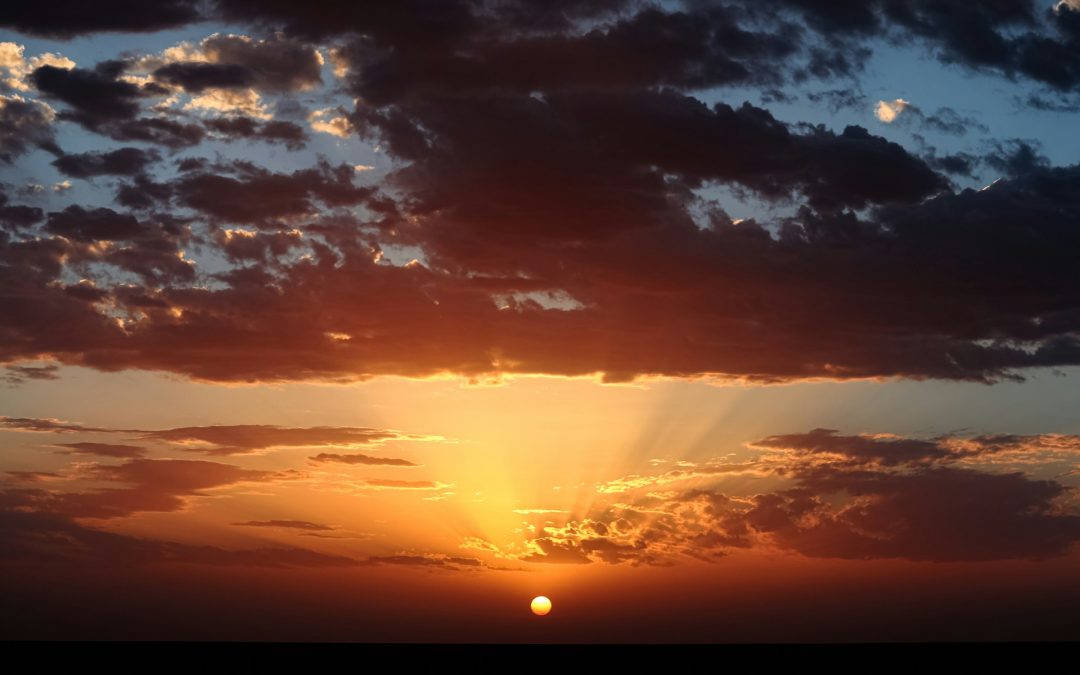Image by Moaz Tobok on Unsplash
No matter how little attention we pay to the outside world and the magical shifts of life turning from season to season, nature has ways of getting our attention as if to prod us back into wonder and awe.
One morning in early fall, I happened to wake up around dawn, which isn’t my habit, and peeked out my east facing bedroom window. The sun was just emerging above the horizon, mostly obscured by suburban rooftops. But there, rising straight up into the clouds was a yellow beam of light, like an angelic finger pointing up to the heavens.
Never in my life had I seen such a phenomenon. I stepped back from the window to make sure it wasn’t just a reflection on the glass. But, no, a golden pillar rose directly from the sun, parting the pink-tinged clouds.
I stood at the window for several minutes, entranced with the solar light show, not thinking about the fact I still had another hour before I had to get up and get ready for work. I wondered if those already on the road were marveling at this natural spectacle, or more focused on the coffee clutched in their hand.
I later discovered that sun pillars, as they’re called, are caused by light refracted by ice crystals. Knowing the science of how this effect occurs didn’t make it any less captivating.
Our rapture over natural occurrences is as ancient as human existence, and its mysteries still confound and delight us. These glimpses of nature’s wonders are moments of awe. Dacher Keltner, professor of psychology at the University of California, Berkeley who has studied the science of awe, describes this emotion as what we experience when we encounter vast mysteries that we don’t understand.
My encounter with the sun pillar certainly fit the bill. In his book Awe: The New Science of Everyday Wonder and How It Can Transform Your Life, Keltner identifies nature as one of eight “wonders of life” that provoke awe as a response. Such wonders transform us, he explains, through the state of mental quietness that occurs when we’re struck with awe, opening our minds to what’s beyond the ego to experience heightened creativity, healthier bodies, and joy.
Sometimes nature has to shock us before we appreciate the opportunity to shed the persistence of egoic self-talk that holds us hostage. Cataclysmic events like wildfires and tsunamis that have devastating consequences leave us awe-struck with nature’s ferocious power. We’re forced to confront our sense of invincibility, and examine our life choices and priorities.
But other natural events can have the opposite effect of evoking child-like wonder and delight. This is happening now where I live which is directly in the path of totality for the April solar eclipse. There’s a fervor that surrounds such cosmic events. We may understand the science behind eclipses and no longer fear them as signs of the apocalypse, but they still have the power to rivet us in wide-eyed astonishment. Watching the sun as it slowly disappears behind a black disc that seems to devour its light; feeling the temperature drop ever so slightly as daylight shifts to darkness, seeps into that part of us that shivers at strange noises or is afraid to look under the bed at night. Mystery is both frightening and titillating. We hold our breath as the sun is swallowed by the moon, and breathe out again in collective relief that we haven’t entered perpetual night. For a few precious minutes, we forget we’re rational beings and turn our faces to the sky, enthralled by magic.
Wonder and delight are by-products of meeting awe in nature. They are compelling emotions, ones that urge us to be completely present. The beauty of the natural world is that we don’t have to wait for an extraordinary event to surrender to the allure of awe.
Everyday wonder can enrapture us if we’re open to noticing. Right now, there are new green shoots pushing up through my neighbor’s garden beds on the verge of blossoming. Buds are thickening on barren branches, soon to shed their skins as new leaves unfurl. Birdsong wakes me in the morning to remind me that it’s spring regardless of what the thermostat says. In a matter of days or even hours, the world will revive; colors will be renewed. To miss these small, everyday transformations is to deprive ourselves of soul-nourishing joy.
There are simple ways that we can approach nature and embrace the blessing of awe in the everyday:
1. Spend a few minutes simply noticing the natural world around you. Make use of all your senses and see, hear, touch, and smell with deep attention.
2. Slow down to the pace of dawdling children. Everything captivates them: caterpillars, clouds, dandelion fluff–it’s easier to regain child-like wonder when you’re not racing to get somewhere.
3. Shift your measurement of time from the calendar to natures’ cycles. Embrace the Celtic Wheel of the Year which focuses on the life-generating processes of planting, growth, harvest, and decay. Living by the seasons can attune you more deeply to the earth’s rhythms and its infinite gifts of intrigue, mystery, and enchantment.


Each season brings some fleeting beauty I managed to forget during the intervening year – a flower, a leaf, an animal call, a different angle of shadow because of the position of the sun. Taking time to notice helps counter-balance the stress of (self-imposed) busyness.
Thanks Marie! I really believe the simple act of noticing nature has the same benefits of sitting meditation. I always have to remind myself to “switch on” the noticing mind!
Elle,
Thanks for the suggestions of ways to embrace nature’s blessings.